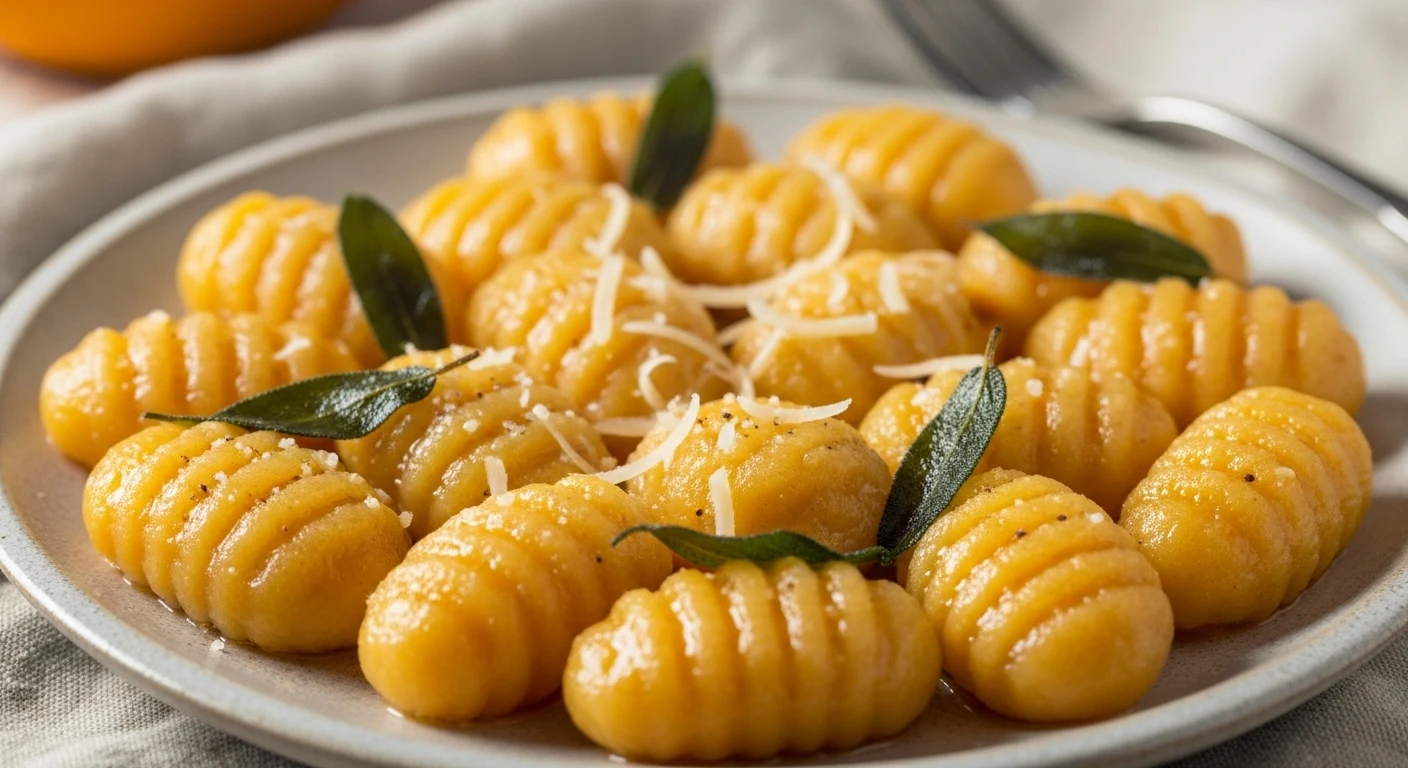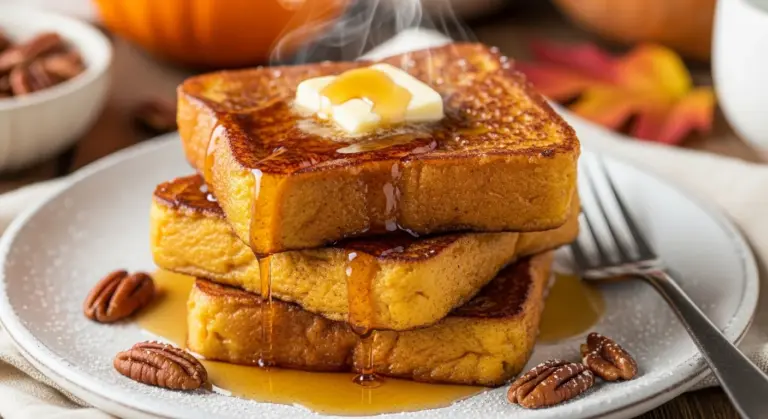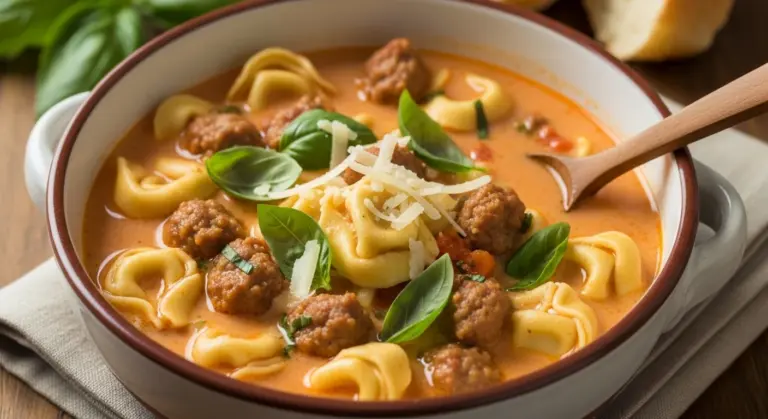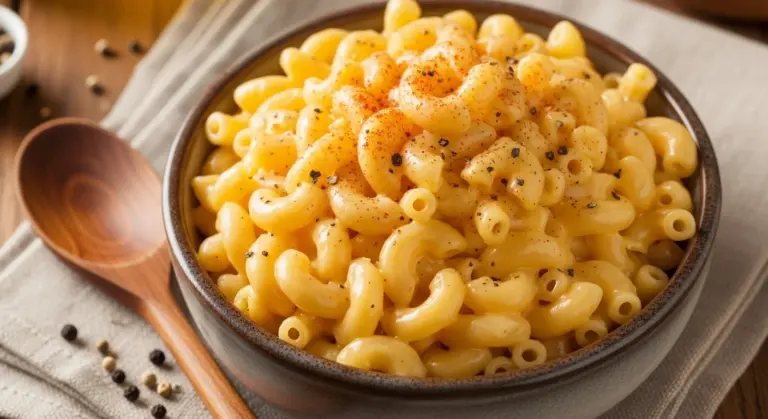I’ll never forget the autumn afternoon I decided to tackle butternut squash gnocchi recipe from scratch.
My neighbor had just dropped off three massive butternut squashes from her garden, and I was determined to do something more exciting than another batch of roasted vegetables.
Little did I know that making gnocchi would become my new favorite weekend project.
The first time I tried making these pillowy orange dumplings, I added way too much flour and ended up with something closer to rubber erasers than Italian pasta.
But once I figured out the right balance, I was hooked. Now, every fall, I make batch after batch, freezing some for those cold winter nights when I need a bowl of comfort.
Quick Recipe Summary:
| Prep Time | 45 minutes |
| Cook Time | 30 minutes |
| Total Time | 1 hour 15 minutes |
| Servings | 4-6 servings |
| Difficulty Level | Intermediate |
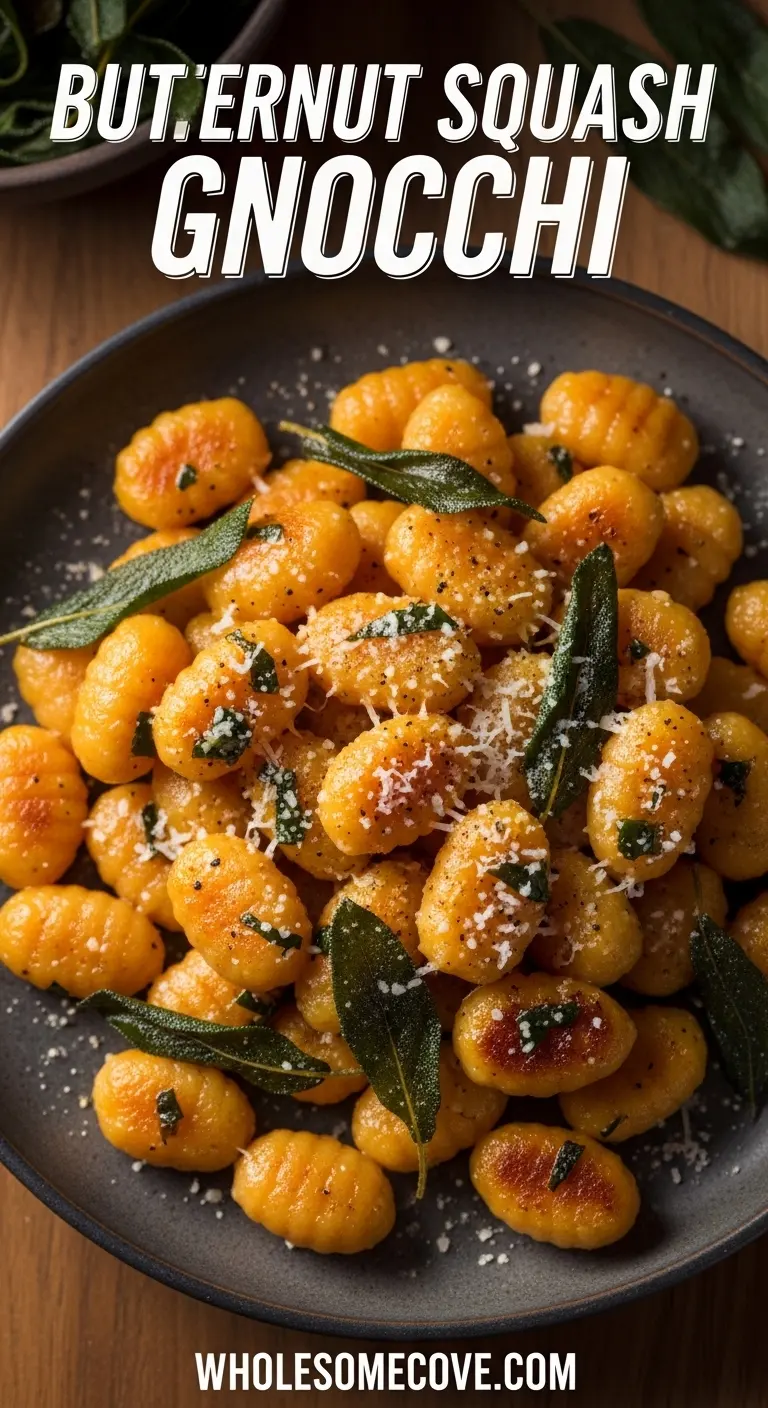
Why You’ll Love This Butternut Squash Gnocchi Recipe
This recipe transforms humble butternut squash into pillowy clouds of pasta perfection that practically melt on your tongue.
The natural sweetness of the squash pairs beautifully with savory sauces, and the vibrant orange color makes every plate look like something from a fancy Italian restaurant. Plus, you’re sneaking in a full serving of vegetables without anyone even noticing.
- Restaurant-quality results at home – These taste better than any gnocchi I’ve ordered out, and I’m not exaggerating
- Freezer-friendly – Make a double batch and freeze half for busy weeknights
- Naturally vegetarian – No modifications needed for your vegetarian friends
- Impressive but manageable – It looks fancy, but once you get the hang of it, it’s actually quite simple
- Customizable texture – You control how tender or firm you want them
- Budget-friendly – One butternut squash makes enough gnocchi for multiple meals
For another comforting pasta dish that’s perfect for fall, try my pumpkin sage pasta.
Ingredients
This recipe relies on just a handful of simple ingredients, but the quality of your butternut squash makes all the difference.
I’ve found that smaller squashes tend to be sweeter and less watery, which means you’ll need less flour and end up with more tender gnocchi.
- 1 medium butternut squash (about 2 lbs / 900g)
- 2 cups all-purpose flour (240g), plus more for dusting
- 1 large egg, lightly beaten
- 1/2 cup freshly grated Parmesan cheese (50g)
- 1 teaspoon salt
- 1/4 teaspoon ground nutmeg
- 1/4 teaspoon black pepper
- 2 tablespoons olive oil (for coating)
Read Also: Butternut Squash Risotto Recipe
Kitchen Equipment Needed
Having the right tools makes the gnocchi-making process so much smoother. Trust me, I learned this the hard way after trying to cut gnocchi with a regular knife the first time.
- Large baking sheet
- Sharp chef’s knife
- Potato ricer or food mill (a fork works in a pinch, but you’ll get better results with a ricer)
- Gnocchi board or fork for creating ridges
- Large mixing bowl
- Bench scraper or knife
- Large pot for boiling
- Slotted spoon or spider strainer
- Clean kitchen towels
Recommended Products for This Recipe
After making this recipe dozens of times, I’ve discovered a few tools and ingredients that genuinely make the process easier and the results better.
1. OXO Good Grips Potato Ricer
This is hands-down the best investment for making gnocchi. It creates the fluffiest, lump-free squash base, which means you need less flour and get more tender gnocchi. I tried using a fork for years, and the difference is night and day.
2. Italian Gnocchi Board
These wooden boards with ridges aren’t just for show – those grooves help sauce cling to your gnocchi. I picked one up at a kitchen store years ago, and it’s become one of my most-used tools. The ridges form in seconds, and it makes you feel like a real Italian cook.
3. King Arthur Flour All-Purpose Flour
The quality of flour matters more than you’d think. I’ve tested this recipe with different brands, and King Arthur consistently gives me the best texture. It’s finely milled, which helps create tender gnocchi that don’t fall apart when boiled.
4. Parmigiano-Reggiano Wedge
Skip the pre-grated stuff for this recipe. A real wedge of Parmigiano-Reggiano adds incredible depth of flavor to the dough. Freshly grated cheese also incorporates more smoothly into the mixture, preventing dry pockets.
Another favorite: Stuffed Acorn Squash Recipe
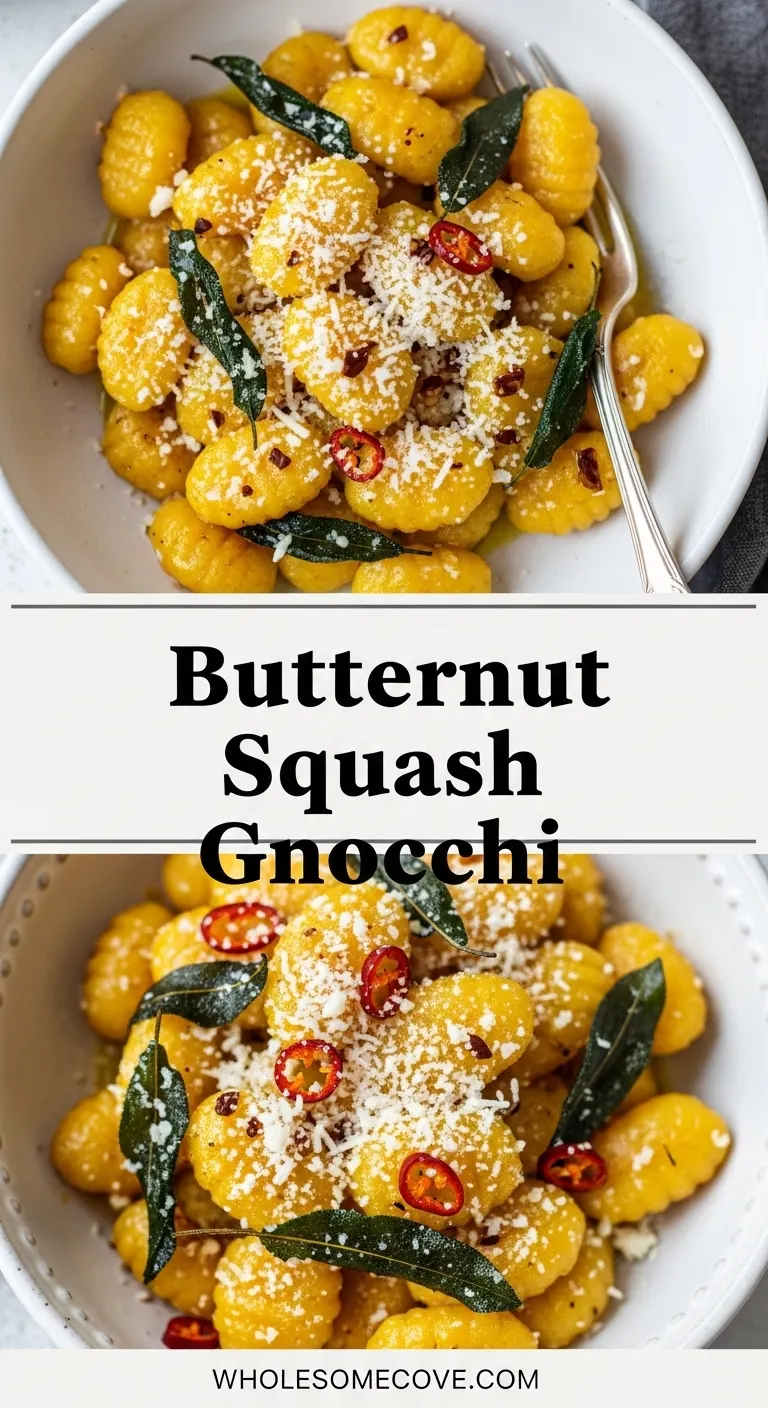
Step-by-Step Instructions: How to Make Butternut Squash Gnocchi
1. Roast the Butternut Squash
- Preheat your oven to 400°F (200°C) and line a baking sheet with parchment paper
- Cut the butternut squash in half lengthwise and scoop out all the seeds and stringy bits with a spoon
- Place the squash halves cut-side down on the prepared baking sheet
- Roast for 40-50 minutes, or until the flesh is completely tender when pierced with a fork – you want it almost collapsing on itself
- Remove from the oven and let it cool for about 10 minutes until you can handle it safely
- Scoop out the flesh into a bowl and let it cool completely to room temperature (this is crucial – hot squash will make your dough too sticky)
2. Prepare the Squash Base
- Once cooled, press the roasted squash through a potato ricer or food mill into a large bowl – this step removes excess moisture and creates a fluffy texture
- If you don’t have a ricer, mash it thoroughly with a fork, but really work at getting all the lumps out
- Spread the riced squash on a clean kitchen towel and gently press to remove any excess moisture – I usually get about 1-2 tablespoons of liquid out
- Measure out 1½ cups (about 350g) of the prepared squash and place it in your mixing bowl
- Let it sit for 5 minutes to release any remaining steam
3. Make the Gnocchi Dough
- Add the beaten egg, grated Parmesan, salt, nutmeg, and black pepper to the squash and mix until well combined
- Start by adding 1½ cups of flour to the mixture and gently fold it in with your hands – the dough should come together but still be slightly sticky
- Add the remaining flour gradually, about 2 tablespoons at a time, until the dough is soft and barely sticky but holds its shape
- Don’t overmix or add too much flour, or your gnocchi will be tough – this was my biggest mistake when I started
- The dough should feel like soft Play-Doh, tacky but not wet
4. Shape the Gnocchi
- Lightly flour your work surface and turn out the dough
- Divide the dough into 6-8 equal portions to make it easier to work with
- Roll each portion into a rope about ¾ inch (2cm) thick – try to keep the thickness consistent for even cooking
- Cut the rope into 1-inch (2.5cm) pieces using a bench scraper or sharp knife
- If you want those classic ridges, gently roll each piece down a gnocchi board or the back of a fork, pressing lightly with your thumb
- As you shape them, place the finished gnocchi on a lightly floured baking sheet, making sure they don’t touch each other
5. Cook the Gnocchi
- Bring a large pot of salted water to a gentle boil – you want it bubbling but not at a rolling boil
- Working in batches of about 20 gnocchi at a time, gently drop them into the water
- Don’t overcrowd the pot, or they’ll stick together and cook unevenly
- The gnocchi will sink to the bottom at first, then float to the surface after 2-3 minutes
- Once they float, let them cook for an additional 30 seconds to 1 minute
- Use a slotted spoon to transfer them to a bowl with a bit of olive oil to prevent sticking
- Repeat with the remaining gnocchi
6. Finish and Serve
- At this point, your gnocchi are ready to be tossed with your favorite sauce
- For a simple finish, I often pan-fry them in butter with sage leaves until they develop a golden crust
- You can also toss them with marinara, brown butter, or cream sauce
- Serve immediately while hot with extra Parmesan cheese on top
You might also enjoy: Roasted Butternut Squash Soup Recipe
Tips for The Best Butternut Squash Gnocchi
Making perfect gnocchi takes a little practice, but these tips will help you avoid the common pitfalls I encountered when I was learning.
- Don’t skip the cooling step – Hot squash will make your dough too wet and you’ll end up adding too much flour trying to compensate
- Use a light hand with flour – Add just enough to bring the dough together; too much flour makes dense, heavy gnocchi
- Test one gnocchi first – Before cooking the whole batch, boil a single piece to check the texture; if it falls apart, add a bit more flour to the remaining dough
- Keep everything floured – Dust your work surface, hands, and rolling pin lightly with flour to prevent sticking
- Work quickly – Once the dough is made, shape and cook it relatively quickly; letting it sit too long can make it gummy
- Don’t overcrowd the pot – Cook in small batches so the water temperature doesn’t drop and the gnocchi cook evenly
- Save some cooking water – The starchy water is perfect for loosening up sauces
- Freeze uncooked for best results – If you’re making ahead, freeze them before cooking, not after
For a lighter pasta option, check out my healthy alfredo sauce.
Serving Suggestions
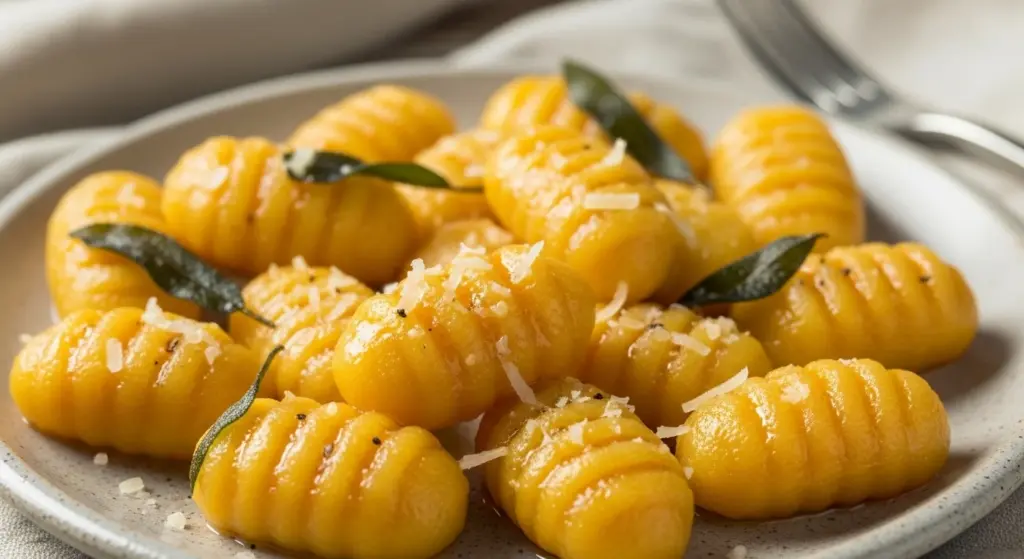
These butternut squash gnocchi are incredibly versatile and pair beautifully with both simple and complex sauces.
My go-to is brown butter with crispy sage leaves and a shower of Parmesan, but the options are endless.
- Brown butter sage sauce – Melt butter until it turns golden and nutty, add fresh sage leaves, and toss with the gnocchi
- Creamy Gorgonzola sauce – The tangy blue cheese balances the squash’s sweetness perfectly
- Simple marinara – Sometimes the classic tomato sauce is all you need to let the gnocchi shine
- Pesto cream sauce – Mix basil pesto with a splash of heavy cream for a luxurious coating
- Garlic and olive oil – Sauté minced garlic in olive oil, add red pepper flakes, and toss
- Serve alongside maple glazed carrots for a complete fall dinner
- Add roasted Brussels sprouts or kale for extra vegetables
- Top with crispy pancetta or prosciutto for a non-vegetarian option
- Finish with toasted pine nuts or walnuts for added crunch
- Pair with a simple arugula salad dressed with lemon vinaigrette
Read Also: Creamy Tomato Basil Soup Recipe
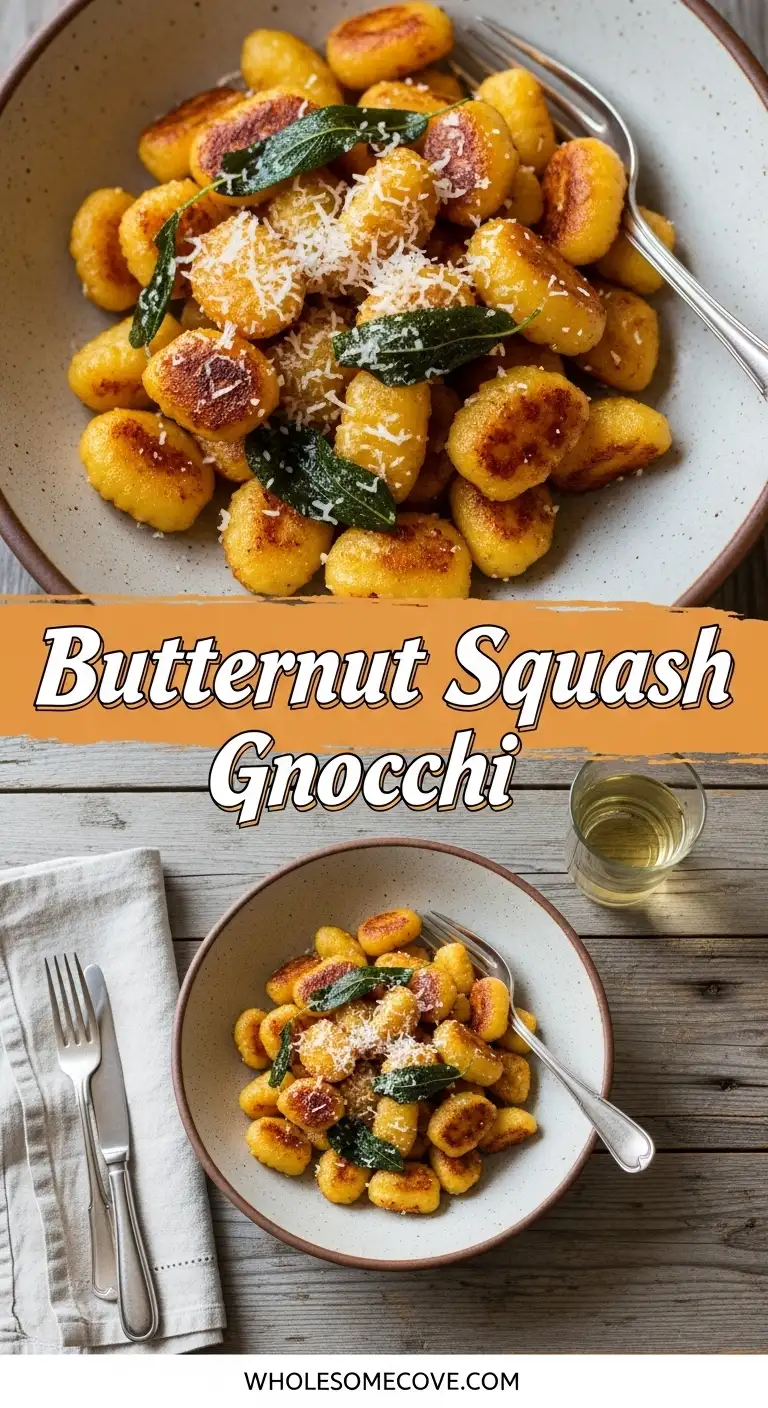
Variations of Butternut Squash Gnocchi
Once you’ve mastered the basic recipe, experimenting with different flavors and mix-ins keeps things interesting.
- Add fresh herbs – Mix chopped rosemary, thyme, or sage directly into the dough for extra flavor
- Sweet potato swap – Replace half the butternut squash with mashed sweet potato for a different flavor profile
- Whole wheat version – Substitute up to half the all-purpose flour with whole wheat flour for added nutrition and a nuttier taste
- Vegan option – Replace the egg with 2 tablespoons of olive oil and use nutritional yeast instead of Parmesan
- Add spinach – Fold in ½ cup of finely chopped, squeezed-dry cooked spinach for color and nutrients
- Ricotta addition – Add ¼ cup of ricotta cheese to make the gnocchi even more tender and fluffy
- Gluten-free adaptation – Use a gluten-free flour blend, though you may need to adjust the ratio
- Cheese variations – Try pecorino romano or aged Asiago instead of Parmesan for different flavor notes
For another comforting fall pasta, try my best lobster mac and cheese.
Storage and Reheating
One of the best things about homemade gnocchi is how well they store, making them perfect for meal prep.
- Refrigerator storage – Store uncooked shaped gnocchi in a single layer on a floured baking sheet, covered with plastic wrap, for up to 24 hours before cooking
- Freezing uncooked gnocchi – Freeze shaped gnocchi in a single layer on a baking sheet for 2 hours, then transfer to freezer bags for up to 3 months; cook directly from frozen, adding 1-2 minutes to the cooking time
- Freezing cooked gnocchi – I don’t recommend freezing cooked gnocchi as they can become mushy when reheated
- Reheating – If you have leftover cooked gnocchi, the best way to reheat is to pan-fry them in butter or olive oil until crispy on the outside
- Storing with sauce – Keep cooked gnocchi separate from sauce if possible; if already mixed, store in an airtight container in the fridge for up to 2 days
- Microwave reheating – Not ideal, but if you must, microwave covered with a damp paper towel for 30-second intervals
- Avoid room temperature – Don’t leave cooked gnocchi at room temperature for more than 2 hours
You might also like: Apple Cider Glazed Pork Chops Recipe
Nutritional Facts
Per serving (based on 6 servings, plain gnocchi without sauce):
- Calories: 245
- Total Fat: 6g
- Saturated Fat: 2g
- Cholesterol: 42mg
- Sodium: 485mg
- Total Carbohydrates: 41g
- Dietary Fiber: 3g
- Sugars: 2g
- Protein: 9g
- Vitamin A: 178% DV
- Vitamin C: 22% DV
- Calcium: 12% DV
- Iron: 15% DV
Note: Nutritional values are approximate and will vary based on specific ingredients used and portion sizes. Values do not include any sauce or toppings.
Another comforting dish: Best Sausage Tortellini Soup Recipe
Health Benefits of Key Ingredients
While gnocchi might seem like pure comfort food, the butternut squash base actually packs in some serious nutritional benefits.
Butternut Squash: This vibrant orange vegetable is loaded with vitamin A, which supports eye health and immune function. It’s also high in fiber, potassium, and vitamin C, while being naturally low in calories. The beta-carotene gives it that gorgeous color and acts as a powerful antioxidant in your body.
Parmesan Cheese: Beyond adding amazing flavor, real Parmigiano-Reggiano is a good source of calcium and protein. It’s also naturally lactose-free, making it easier to digest for those with lactose sensitivity.
Nutmeg: This warming spice isn’t just for flavor – it contains compounds that may help with digestion and has been used traditionally to aid sleep and reduce inflammation.
Eggs: The egg in this recipe provides high-quality protein and binds everything together while adding important nutrients like vitamin B12, vitamin D, and choline, which supports brain health.
For more healthy comfort food, try my healthy shepherds pie.
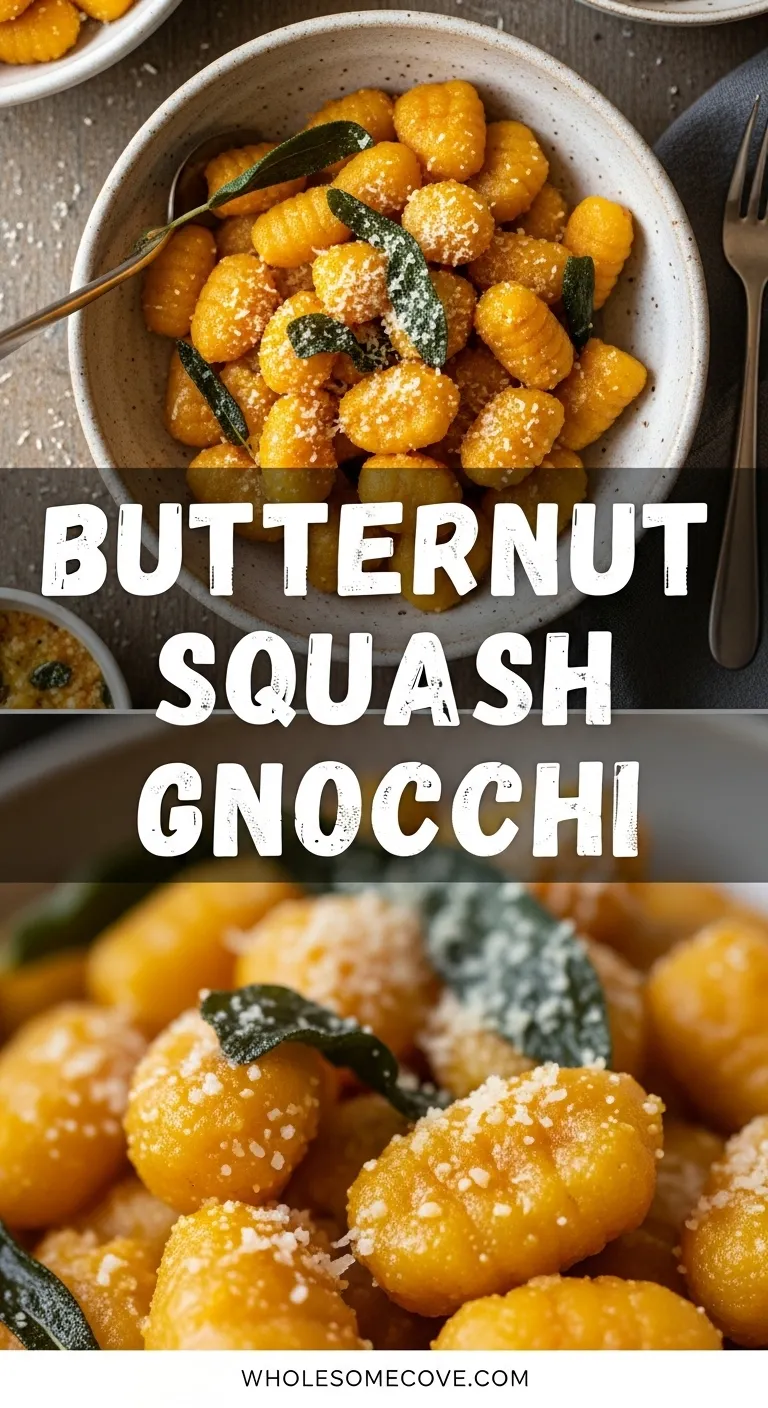
FAQs About Butternut Squash Gnocchi
1. Why did my gnocchi fall apart when cooking?
This usually happens when the dough has too much moisture or not enough flour to bind it together. Make sure your roasted squash is completely cooled and well-drained before mixing the dough.
I always test one gnocchi before cooking the whole batch – if it falls apart, I gently knead in another tablespoon or two of flour. Also, make sure your water is at a gentle simmer, not a rolling boil, which can break apart delicate gnocchi.
2. Can I make the dough ahead of time?
Yes, but with some caveats. I find that freshly made dough works best, but you can refrigerate it for a few hours if needed. Wrap it tightly in plastic wrap to prevent it from drying out.
For best results, I recommend shaping the gnocchi and then freezing them rather than refrigerating the dough itself. Frozen shaped gnocchi can be cooked directly from the freezer and actually hold their shape better than refrigerated dough.
3. How do I know when I’ve added enough flour?
This is the trickiest part of gnocchi-making! The dough should be soft and slightly tacky to the touch, but it shouldn’t stick to your hands when you handle it.
When you press a finger into the dough, it should spring back slowly. If it’s too wet and sticks everywhere, add more flour a tablespoon at a time. Remember, it’s easier to add more flour than to fix gnocchi that are too dense from too much flour.
4. Why are my gnocchi dense and heavy instead of light and fluffy?
This is almost always from adding too much flour or overworking the dough. Butternut squash has a different moisture content than potatoes, so it’s tempting to add more flour, but resist! Mix the dough just until it comes together, and handle it as little as possible.
Also, make sure you’re pressing the squash through a ricer or mashing it very smoothly – lumpy squash requires more flour to come together, which leads to dense gnocchi.
5. Can I use a different type of squash?
Absolutely! I’ve successfully made this recipe with kabocha squash, which has a drier texture and requires slightly less flour. Sweet potatoes work beautifully too, though they’ll need a bit more flour than butternut squash.
Regular pumpkin tends to be too watery for gnocchi. Whatever you use, the key is roasting it until it’s very dry and fluffy, then making sure it’s completely cool before making the dough.
Read Also: Velveeta Mac and Cheese Recipe
Final Thoughts
Making butternut squash gnocchi from scratch is one of those kitchen projects that seems intimidating at first but becomes deeply satisfying once you get the hang of it.
Yes, there’s a learning curve, and your first batch might not be perfect. But even imperfect homemade gnocchi tastes better than anything you’ll buy at the store.
The key is not to stress too much about getting them perfectly uniform or shaped. Focus on getting the dough texture right, and the rest will follow with practice.
I love making a big batch on lazy Sunday afternoons, freezing half, and having homemade gnocchi ready to go for those nights when I want something special without the effort. Toss them with whatever sauce sounds good, pour yourself a glass of wine, and enjoy the fruits of your labor.
Give this butternut squash gnocchi recipe a try, and let me know how it turns out! Do you prefer them pan-fried until crispy or tossed in a creamy sauce? Drop a comment below and share your favorite way to serve them.
Recommended:
- Carrot Ginger Soup Recipe
- Poached Pear Recipe
- Homemade Cinnamon Applesauce Recipe
- Slow Cooker Chili Recipe
- Beef Barley Soup Recipe
- Apple Crisp Recipe
- Roasted Brussels Sprouts With Bacon Recipe
- Mulled Apple Cider Recipe
- Fall Dinner Recipes
- Healthy Chicken Pot Pie Recipe

